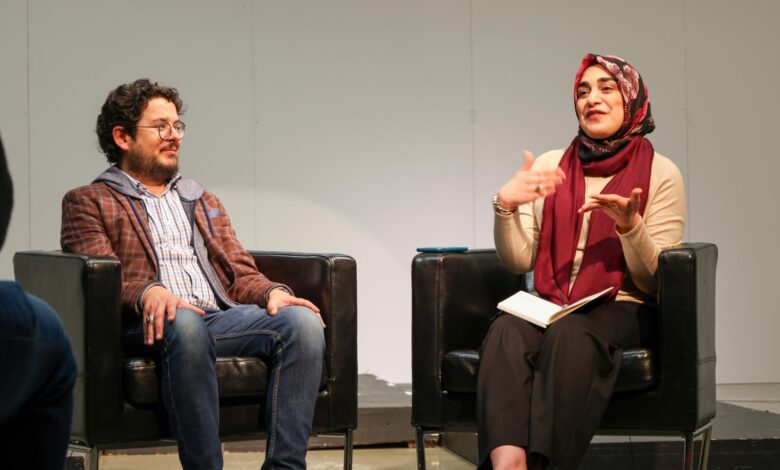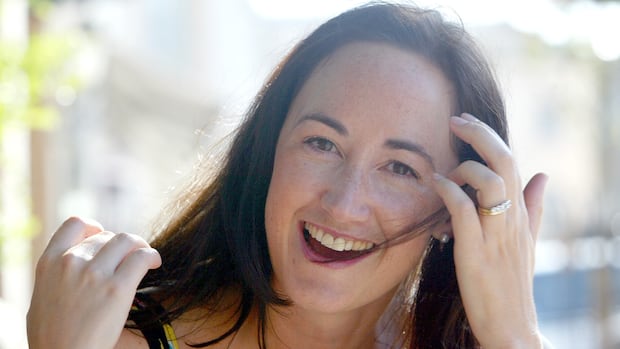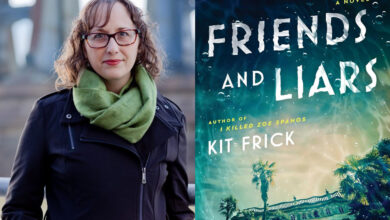Event on author Rusha Latif’s book packs Marcus Hall studio – Golden Gate Xpress

Marcus Hall’s Studio 1 usually prepares around 20 seats for guests during lectures. When over 35 attendees turned out to hear Rusha Latif speak about revolution, liberation, praxis and her book, “Tahrir’s Youth: Leaders of a Leaderless Revolution,” on Wednesday, they had to bring out more chairs.
The Egyptian-American author came to speak at San Francisco State University after Dina Ibrahim, a Broadcast Electronic Communications Arts professor, reached out to Latif through connections in the Egyptian activist community. Latif’s book covers the Egyptian revolution of 2011 and how it came to be through wide-ranging student activism and organizing.
In an interview conducted before the event, Latif spoke at length about the connections between the Egyptian revolution and students’ pro-Palestinian protests over the last two years, including student encampments, like at SFSU during the Spring 2024 semester.
“What the young people did on January 25 was that they managed to get all these people to come to the square, and then occupied it and they set up tents. I don’t think that we had seen that model before,” Latif said. “The Egyptian revolution was the first major revolutionary movement we had in the 21st century, globally, that sort of looked and had the theatrics of revolution.”
Though the 2011 Egyptian revolution took inspiration from a then-recent uprising in Tunisia that managed to bring down its government, Latif refers to the student-led coalition that sparked a movement in Egypt. Activists involved in the day of protest chose the date of January 25 to stand against Egypt’s then-recent cases of police brutality, including Egyptian police officers’ torture and beating of Khaled Said in 2010, and to coincide with Egypt’s “Police Day” on that date.
The protests hoped to introduce steps toward the end of Hosni Mubarak’s reign as president of Egypt after over 30 years in the role. Mubarak eventually stepped down in February 2011 after over 6,500 people were injured and 840 people were killed.
“Before January 25, these youth movements were active on the ground,” Latif said. “A lot of these young activists were first radicalized by the Palestinian Intifada in the year 2000. If you were to ask any of them when the revolution actually started, they wouldn’t say on January 25, 2011, they would date it back to the year 2000, to the Palestinian Intifada.”
Latif referred to the Second Palestinian Intifada, where Jamal al-Durrah and Muhammad al-Durrah, a father and son, were filmed being shot at by Israeli military, who ended up shooting and killing Muhammad al-Durrah in 2000.
“They were politicized and radicalized for the first time. They participated in the mass street protests, but also organized their own actions and major disruptions on their university campuses,” Latif said. “So that’s really an important link. You know, I can even have a title like ‘Tahrir, Gaza, and Beyond: Revolution, Liberation, and Praxis’ because these struggles are so interconnected.”
By the time the event started on Wednesday, there was a buzzing excitement in the room, filled with students to hear Latif speak about the ties between struggles for liberation over the decades. Latif spoke about her book, which focuses on the narratives of 10 activists and their life stories, spanning from before the start of the revolution to its end.
One of those students who filled the studio was Max Flynt, a member of SFSU’s chapter of General Union of Palestine Students.
“I wanted to get an in-depth analysis from the author themselves and also to hear from Professor Omar Zahzah, one of our esteemed professors here at SF State, who brings a lot here to our school,” Flynt said.
Zahzah, an assistant professor of Arab and Muslim ethnicities and diaspora studies at SFSU, chaired the Q&A after Latif spoke about her book. In an interview prior to the conversation, Zahzah underlined why Latif’s presence on campus would be important.
“Part of the importance of Rusha’s work is really showing the huge influence that Palestine solidarity had on the uprisings,” Zahzah said. “When you look at it in that perspective, you see how Palestine is such a fundamental cause in relation to broader anti-oppressive struggles. Where you’re fighting oppression, Palestine is always relevant.”
Latif zeroed in on how she believed that there was an eradication of political spaces under Mubarak and that student organizing’ efforts to confront and change that was what led to the revolution gaining steam until it pushed Mubarak to resign. Latif’s emphasis on student protests remained constant.
14 years later, CNN reported that over 1,000 international students in the US have had their visas revoked this year with many students having them revoked because of their association with pro-Palestinian protests.
“We still feel a connection to our countries of origin, but we have to recognize that our roles might be different and how to respect boundaries to engage with those movements,” Latif said.
The whole conversation between Latif and Zahzah can be viewed on the SFSU BECA YouTube channel.
This story has been corrected for accuracy.
Source link



